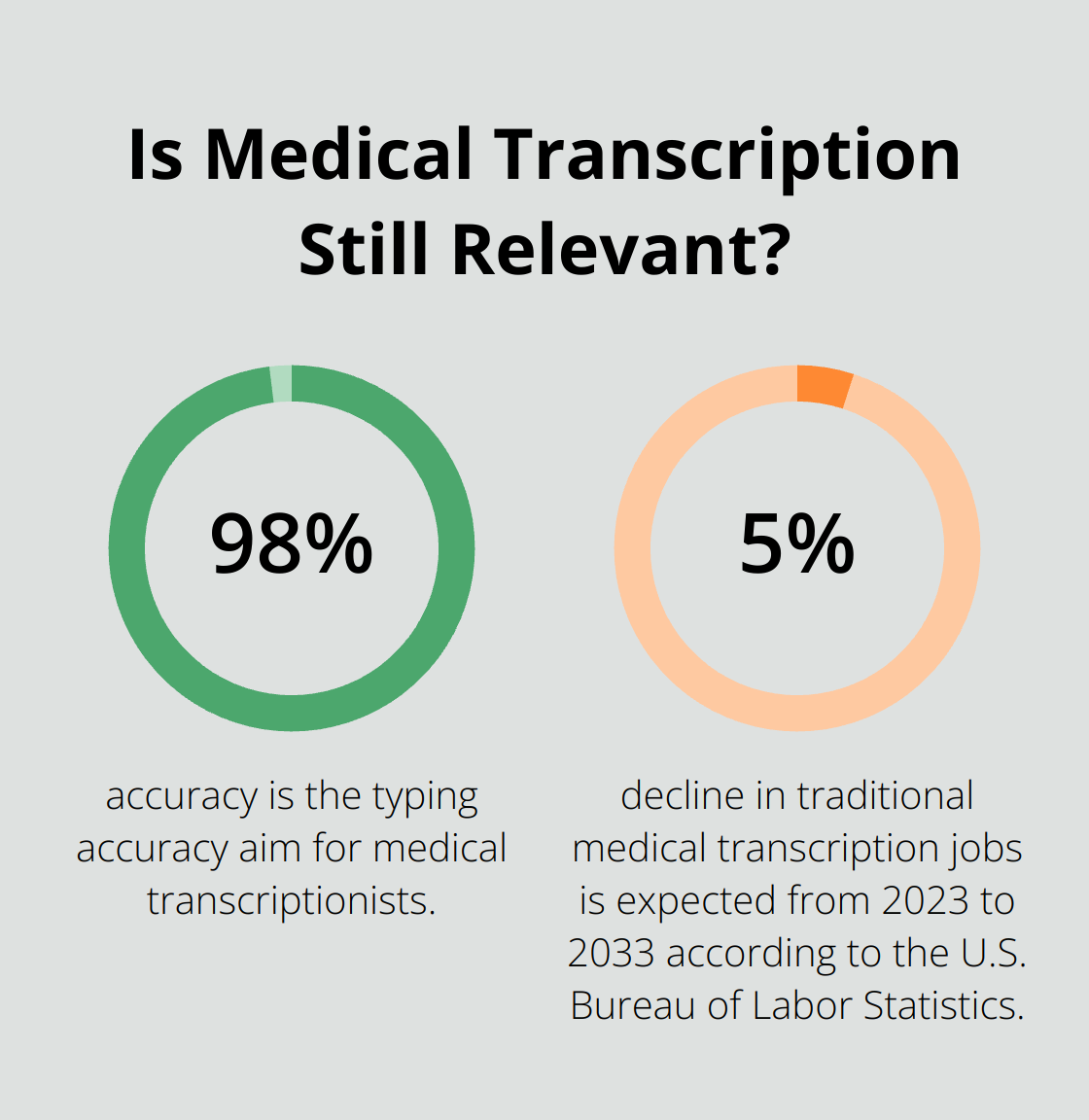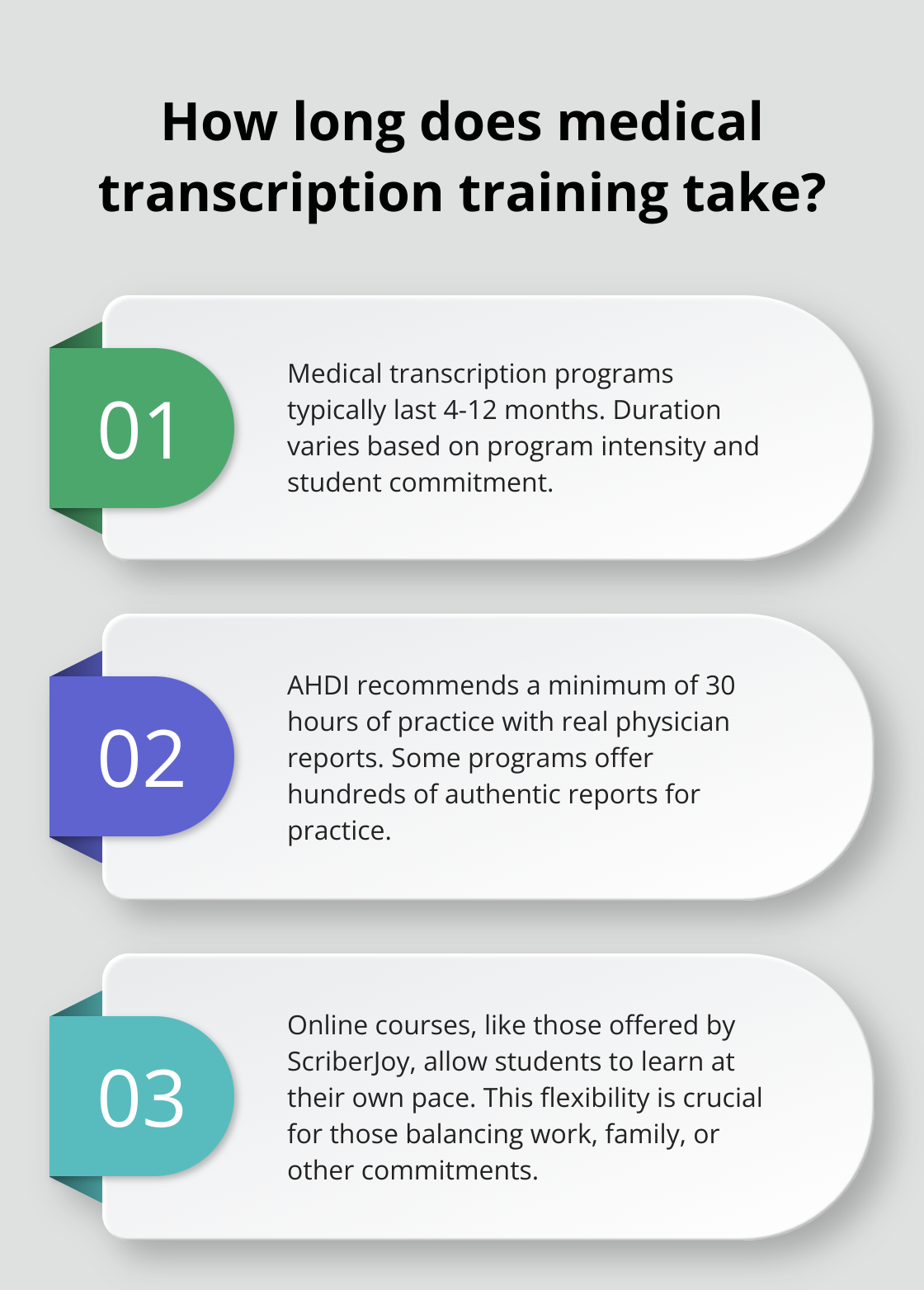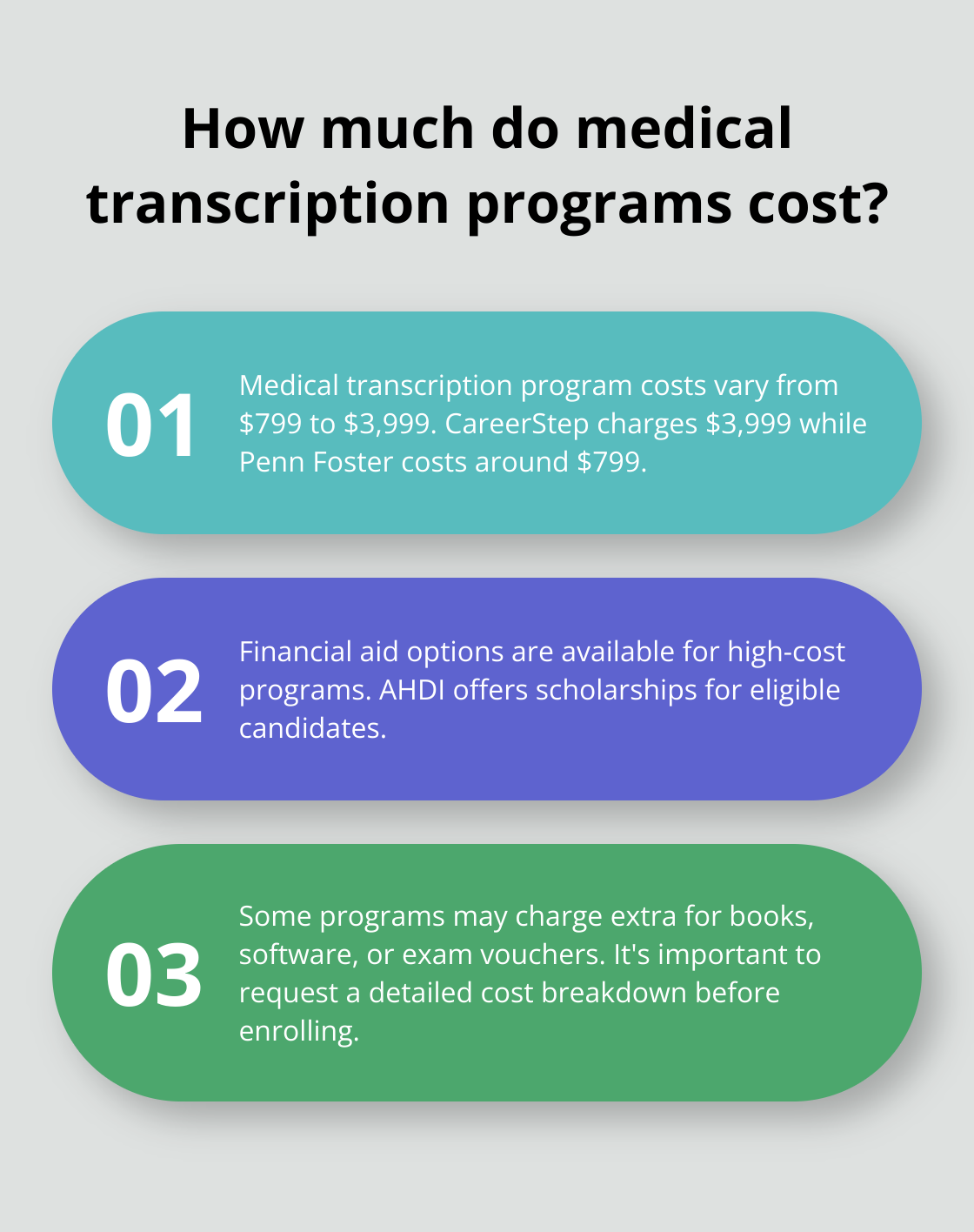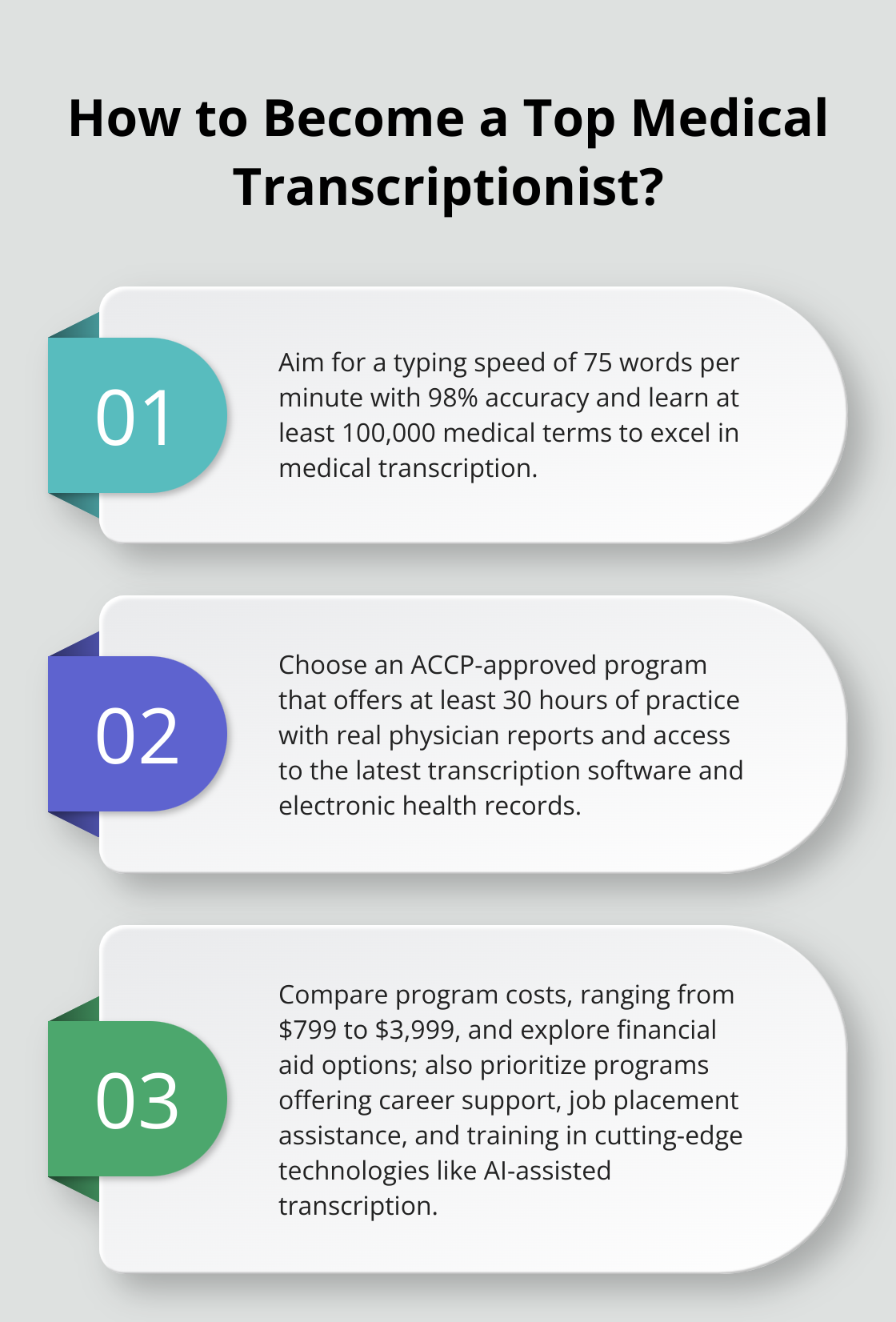Picking the right medical transcription training program—it’s either a home run or total strikeout for your career. At ScriberJoy, we’ve witnessed up close how the right education can be a game-changer in medical transcription.
This guide is your compass in the overwhelming ocean of choices, setting you on course to the best program for your needs. We’ll dive into everything from accreditation to job placement assistance (the nitty-gritty that matters), giving you all the deets you need to make a savvy choice…I mean, who doesn’t like being informed?
What Is Medical Transcription Training?
Definition and Purpose
So, medical transcription training-what’s the buzz here? It’s all about taking those voice-recorded reports from docs and turning them into crisp, clear written documents. Simple, right? But crucial. Think about it-patient records need to be spot-on accurate and fresh as a daisy. Lives kinda depend on it.
The Necessity of Comprehensive Training
Why do we need to go full throttle with medical transcription training? Because let’s face it, you can’t just wing it in this field. You need legit, top-notch training. Completing a certificate program will get you in the game-to actually work as an MT, though, you gotta ace that certification exam from those folks at the Association for Healthcare Documentation Integrity (AHDI). Why all the fuss, you ask? Because messing up medical records can lead to some gnarly problems for patient care.
Core Competencies for Medical Transcriptionists
Wanna smash it in this field? Gotta stack up on these skills:
- Typing wizardry: Aim for 75 words per minute, with ninja-like accuracy of 98%.
- Mastery of medical lingo: Wrap your head around 100,000+ medical terms. Yep, it’s a lot.
- Know your anatomy: Gotta get the lowdown on human body systems for flawless transcription.
- Eagle eye for detail: Even a tiny slip-up can cause major headaches in medical records.
- English language chops: Polish those grammar and punctuation skills-these tools are your bread and butter.
Training Program Options
How do you become a medical transcriptionist? Plenty of paths to explore:
- Certificate programs: A quick six to twelve months is all it takes in community colleges and vocational schools.
- Associate degree programs: Two years of diving deep, with some gen ed courses thrown in.
- Online courses: Flex those self-paced muscles on platforms like CareerStep-or ScriberJoy if cutting-edge AI is your jam. Finish in as little as four months.
- On-the-job training: Some healthcare places train you on the fly-though it’s going a bit out of style.

When you’re picking a program, look at things like accreditation, curriculum, and job hookups. Programs blessed by the Approval Committee for Certificate Programs (ACCP) are the real deal in the industry.
The Evolving Landscape of Medical Transcription
Fast-forward to the ever-changing world of medical transcription. Sure, the U.S. Bureau of Labor Statistics says we’re looking at a 5% dip in old-school MT gigs from 2023 to 2033-but don’t sweat it. New gigs are popping up in specialized areas, and there’s some cool tech in play. Training in these cutting-edge tools (hello, speech recognition software) can give you a killer edge in the job market.
As we cruise ahead, it’s key to size up the training programs out there-get the lowdown on the most robust and up-to-the-minute education in this ever-shifting field of medical transcription.
How to Evaluate Medical Transcription Training Programs
Accreditation: The Foundation of Quality
When deciding on a medical transcription training program, accreditation should be at the top… why? Well, it’s your seal of quality. The Association for Healthcare Documentation Integrity (AHDI)-they’re the gatekeepers, setting and upholding the gold standard here. They ensure education and practice aren’t just good… but great, preserving accuracy, privacy, and quality like it’s Fort Knox. So, programs that get the nod from the Approval Committee for Certificate Programs (ACCP)? That’s the high ground. They’ll get you ready for certification exams like Registered Healthcare Documentation Specialist (RHDS), which-let’s face it-can turbocharge your career prospects.
Curriculum: The Core of Your Education
What’s the lifeblood of any solid training program? The curriculum… it’s all about the content, baby. You’re hunting for courses that dive deep into:
- Medical terminology (speak the language)
- Anatomy and physiology (know the parts)
- Pharmacology (meds and mechanisms)
- Healthcare documentation practices (document like a pro)

Top-tier programs, think CareerStep, aren’t just sitting pretty. They’re on the cutting edge, offering the latest in transcription software and electronic health records. They throw in exam vouchers, so you’re ready for that RHDS certification, which isn’t just multiple-choice-it’s multiple types: fill-in-the-blank, transcription… it’s the whole shebang.
Hands-On Experience: Practice Makes Perfect
Let’s get real-just theory? It’s not getting you anywhere in medical transcription. The cream of the crop programs? They offer hands-on practice… lots of it. Real-world medical dictations come into play here. The AHDI’s take? At least 30 hours with actual physician reports-bare minimum. Some programs go the extra mile, giving you access to hundreds of authentic reports for real-time practice. This hands-on, down-and-dirty training? Priceless as you kick-start your career.
Instructor Expertise: Learn from the Best
Instructors can make or break your learning experience-seriously. Look for programs led by Certified Medical Transcriptionists (CMTs) seasoned in the field. These pros? They bring insights to the table that textbooks only dream of. They’ll drop real-world scenarios, tips, tricks-stuff you can’t afford to miss if you want to succeed.
Program Flexibility: Fit Training into Your Life
How the program’s structure meshes with your life… that’s critical. Many top-notch programs (like ScriberJoy) offer online courses that let you go at your own speed. This flexibility? Key-especially if you’re juggling work, family, or life itself while you’re training.
As you’re weighing your options, don’t be shy-poke around and ask program administrators about their curriculum, instructors, job placement rates. Putting in the legwork now? It sets the stage for a thriving career in medical transcription. Up next, let’s drill down into the pivotal factors when making that final decision on a training program.
What Factors Matter Most in Choosing a Training Program?
Cost and Financial Aid Options
Let’s talk money… because it matters. Medical transcription programs-you’re looking at a range here-somewhere from a few hundred bucks up to several grand. Take CareerStep, you’re shelling out about $3,999 there, while Penn Foster is a softer hit to the wallet at around $799. But here’s the kicker-don’t let those high tags freak you out. There’s this thing called financial aid. Look into it.

Get all the fine print on those costs before you ink anything. Some places will ping you extra for books or software… or even those pesky exam vouchers. Ask for the nitty-gritty breakdown. Hunt down scholarships-AHDI’s tossing some dollars your way if you fit the bill.
Program Flexibility
In today’s hustle-bustle, flexibility isn’t just a perk-it’s a must. Online programs let you run the show at your pace. Got a job or kids? No prob. But if structure keeps you sane, scope out programs with deadlines. Some even offer this hybrid thing… online learning meets real-life workshops. Best of both worlds? Maybe.
Career Support and Job Placement
Classrooms are cool, but post-program…? That’s the real test. Scout out programs bragging about top-notch career support. Workshops on resumes, interviews, job placements-you want it all.
But don’t just buy the sales pitch. Demand specifics. Job placement stats, what positions did grads land, average starting paycheck… get the lowdown on your future prospects.
Technology and Industry Relevance
The world of medical transcription-always changing. You need training that gets ahead of the curve. Go for programs pushing the envelope with tech, like speech recognition software. ScriberJoy’s doing it with AI-assisted transcription. That’s future-proof training right there.
Networking Opportunities
Never underestimate who you know. Programs with solid industry ties can crack open doors to internships and jobs. Sniff around for connections with hospitals or transcription gigs. These links could be your golden ticket.
Educational Requirements
Size up your training pick based on your educational background. High school diploma or GED-most employers start there. But some lean toward candidates with more schooling under their belt in medical transcription or similar fields. Make sure you’re checking those boxes.
Final Thoughts
Picking the right medical transcription training program? It’s not just a decision-it’s the decision that’ll launch your career. You want the big five: accreditation, killer curricula, hands-on experience, expert teachers, and flexibility. These aren’t just buzzwords; they’re your career’s foundation. Sure, cost is a biggie, but don’t let it steer the whole ship. Financial aid and scholarships? Yeah, look into those-make that education affordable and accessible.

The field of medical transcription is a fast-moving train, constantly upgraded with shiny new tech. You gotta choose a program that not only keeps up but runs ahead of the latest industry trends. Think cutting-edge tools baked right into the learning process. That’s how you’re going to be ready for the modern healthcare hustle. And here’s the secret sauce: know yourself. Self-assessment is your best friend in finding the right fit for your ambitions and situation.
At ScriberJoy, we totally get how crucial it is to stay on top of your game in the medical transcription scene. We bring you AI-assisted transcription services that blend the newest tech with expert human touch. It’s a fantastic platform for honing your skills after you finish your education (though heads up-we’re not a training program).

Leave a Reply
You must be logged in to post a comment.